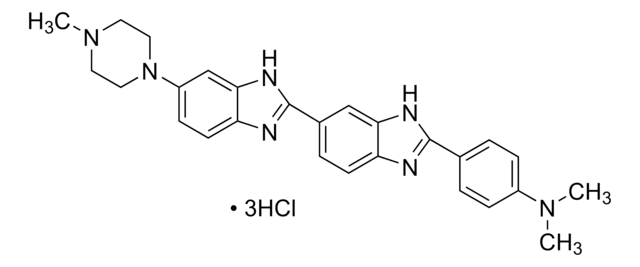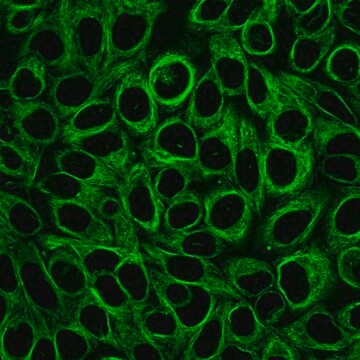94403
Hoechst 33258 solution
1 mg/mL in H2O, ≥98.0% (HPLC)
Synonym(s):
bisBenzimide H 33258 solution
About This Item
Recommended Products
Assay
≥98.0% (HPLC)
form
liquid
concentration
1 mg/mL in H2O
solubility
DMF: soluble
H2O: soluble
fluorescence
λex 355 nm; λem 465 nm in TE buffer; DNA
storage temp.
2-8°C
SMILES string
Cl.Cl.Cl.CN1CCN(CC1)c2ccc3[nH]c(nc3c2)-c4ccc5nc([nH]c5c4)-c6ccc(O)cc6
InChI
1S/C25H24N6O.3ClH/c1-30-10-12-31(13-11-30)18-5-9-21-23(15-18)29-25(27-21)17-4-8-20-22(14-17)28-24(26-20)16-2-6-19(32)7-3-16;;;/h2-9,14-15,32H,10-13H2,1H3,(H,26,28)(H,27,29);3*1H
InChI key
SMNPLAKEGAEPJD-UHFFFAOYSA-N
General description
Application
Storage Class Code
10 - Combustible liquids
Flash Point(F)
Not applicable
Flash Point(C)
Not applicable
Choose from one of the most recent versions:
Already Own This Product?
Find documentation for the products that you have recently purchased in the Document Library.
Customers Also Viewed
Protocols
Learn to culture ReNcell® human neural stem cells (NSCs) in 3D hydrogels like the TrueGel3D® HTS Hydrogel Plate using this step by step protocol for high-throughput screening cell culture applications.
Learn how to culture human adipose mesenchymal stem cells (MSCs) in 3D hydrogels like the TrueGel3D® Hydrogel Plate using this step-by-step protocol for high-throughput screening cell culture applications.
Our team of scientists has experience in all areas of research including Life Science, Material Science, Chemical Synthesis, Chromatography, Analytical and many others.
Contact Technical Service









